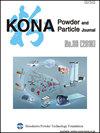On the Similarity of Austin Model and Kotake–Kanda Model and Implications for Tumbling Ball Mill Scale-up
IF 3.2
4区 材料科学
Q3 ENGINEERING, CHEMICAL
引用次数: 5
Abstract
The aim of this theoretical investigation is to seek any similarities between the Austin model and the Kotake–Kanda (KK) model for the specific breakage rate function in the population balance model (PBM) used for tumbling ball milling and assess feasibility of the KK model for scale-up. For both models, the limiting behavior for small particle size-to-ball size ratio and the extremum behavior for a given ball size are described by “power-law.” Motivated by this similarity, specific breakage rate data were generated using the Austin model parameters obtained from the lab-scale ball milling of coal and fitted by the KK model successfully. Then, using the Austin’s scale-up methodology, the specific breakage rate was scaled-up numerically for various mill diameter scale-up ratios and ball sizes of 30–49 mm and coal particle sizes of 0.0106–30 mm. PBM simulations suggest that the KK model predicts identical evolution of the particle size distribution to that by the Austin model prior to scale-up. Upon scale-up, the differences are relatively small. Hence, modification of the exponents in the Austin’s scale-up methodology is not warranted for scale-up with the KK model. Overall, this study has established the similarity of both models for simulation and scale-up.Austin模型与kotakekanda模型的相似性及其对滚筒式球磨机放大的启示
本理论研究的目的是寻找Austin模型和kotakekanda (KK)模型在翻滚球磨人口平衡模型(PBM)中特定破碎率函数的相似之处,并评估KK模型用于放大的可行性。对于这两种模型,小颗粒尺寸与球尺寸比的极限行为和给定球尺寸的极值行为都用幂律来描述。基于这一相似性,利用煤的实验室球磨得到的Austin模型参数生成特定破碎率数据,并成功地用KK模型拟合。然后,采用Austin 's放大方法,对不同磨机直径放大比、球粒度为30-49 mm、煤粒度为0.0106-30 mm的破碎率进行数值放大。PBM模拟表明,KK模型预测的颗粒尺寸分布的演变与Austin模型预测的相同。放大后,差异相对较小。因此,对于KK模型的放大,不需要修改Austin的放大方法中的指数。总的来说,本研究建立了模拟和放大模型的相似性。
本文章由计算机程序翻译,如有差异,请以英文原文为准。
求助全文
约1分钟内获得全文
求助全文
来源期刊

KONA Powder and Particle Journal
工程技术-材料科学:综合
CiteScore
8.40
自引率
4.90%
发文量
35
审稿时长
>12 weeks
期刊介绍:
KONA publishes papers in the broad field of powder science and technology, ranging from fundamental principles to practical applications. Papers describing technological experience and critical reviews of existing knowledge in special areas are also welcome.
 求助内容:
求助内容: 应助结果提醒方式:
应助结果提醒方式:


